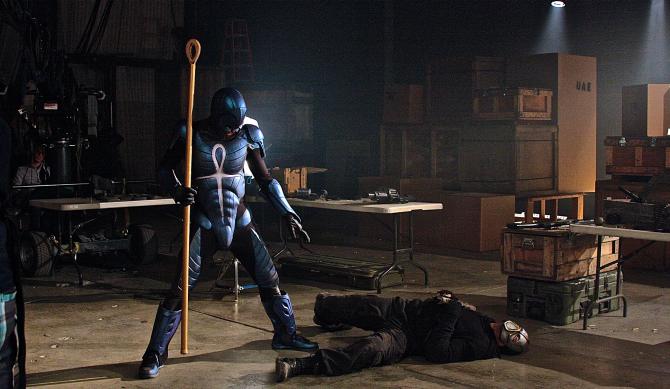[ad_1]

Scene from The Legend of Mantamaji
Courtesy of Eric Dean Seaton
Editor’s note: This short-film series is a collaboration between The Root and El Rey Network to support, elevate and promote African-American filmmakers throughout Black History Month via on-air, digital and editorial platforms. Filmmakers were contacted and recruited through film festivals and industry partnerships in December, with finalists selected by both El Rey Network and The Root based on quality, subject matter, and suitability for broadcast and digital exhibition. These talented filmmakers represent the front line in improving diversity of participation and cultural representation in entertainment. Both The Root and El Rey Network are honored to showcase their works and stories.
Symbolism reigns supreme in the short film Legend of Mantamaji. The superhero’s secret weapon is an ankh that morphs into an array of swords, whips and shields to combat a battalion of enemy forces armed with a variety of guns. It’s a superhero science fiction-action drama written and directed by Eric Dean Stanton, based on the graphic novel of the same name that he created.
Stanton has written and directed dozens of TV shows, from That’s So Raven to Dr. Ken. He took a moment to discuss his latest project with The Root.
The Root: What is the genesis of the graphic novel and the short?
Eric Dean Seaton: [When I was] growing up, my dad worked out of town and used to come home on the weekends and take me to a coffee shop that had comic books. Years later, when I moved to California, I lived down the street from a comic book shop. And finally, one of my first jobs was on the Fox sitcom Living Single. The director was married to the president of Marvel Comics, so every Tuesday, shoot day, I would drill him about all things Marvel.
Finally, he invited me down to a company they bought called Malibu Comics. After a tour, the editor asked me if I wanted to write a “Spider-Man, Stop the Violence” special. I did, but Marvel went into bankruptcy, so I never received a copy. After that, I knew I had to do my own.
I would say there is a profusion of [black] superhero sidekicks and co-stars on-screen. There is not a lead superhero of color on any screen anywhere. There won’t be one in theaters until 2018, and even he will be introduced as a story point for other nonblack heroes. We still have a long way to go, but hopefully Legend of the Mantamaji is showing that we can be a main hero and that the story is just as good, if not better.
TR: What were the biggest obstacles in getting this made?
EDS: Taking up a short of this scale and scope was a great challenge. Everyone worked for next to nothing, and I called in all my favors because we had to make everything, from the costumes to the villain’s masks to all the weapons, and nothing except the guns was rentable. We actually had more weapons like nunchucks and a hammer, but they either broke in rehearsal or didn’t look quite right, so we made changes on the fly.
TR: What is the next step for Legend of Mantamaji?
EDS: We would love to make more shorts about Mantamaji and some of the other characters. We didn’t get a chance to show all the strong female characters that are in the books. We also have the next set of books coming out that continue the story, called Legend of the Mantamaji: Bloodlines.
I think digital shorts are the wave of the future. In the six minutes it takes you to watch the live-action short, you see the hero’s strength, weaknesses and powers. You get a total feel of what the story is about and what the hero can and cannot do. I hope I get to do more.
Watch The Legend of Mantamaji:
The Legend of Mantamaji will also air on El Rey Network immediately following the listed features (all times EST): Reservoir Dogs, Saturday, Feb. 20, 10 a.m. and 6 p.m., and Saturday, Feb. 27, 4 p.m. and 10:30 p.m.; Shaolin Abbot, Feb. 25, 8 p.m. and 11:45 p.m.
Editor’s note: Other films in the series also on The Root:
[ad_2]






















